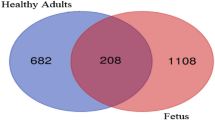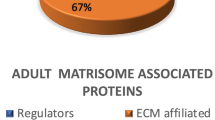Abstract
It is widely assumed that as connective tissue, the intervertebral disc (IVD) plays a crucial role in providing flexibility for the spinal column. The disc is comprised of three distinct tissues: the nucleus pulposus (NP), ligamentous annulus fibrous (AF) that surrounds the NP, and the hyaline cartilaginous endplates (CEP). Nucleus pulposus, composed of chondrocyte-like NP cells and its secreted gelatinous matrix, is critical for disc health and function. The NP matrix underwent dehydration accompanied by increasing fibrosis with age. The degeneration of matrix is almost impossible to repair, with the consequence of matrix stiffness and senescence of NP cells and intervertebral disc, suggesting the value of glycoproteins in extracellular matrix (ECM). Here, via database excavation and biological function screening, we investigated a C-type lectin protein, CLEC3A, which could support differentiation of chondrocytes as well as maintenance of NP cells and was essential to intervertebral disc homeostasis. Furthermore, mechanistic analysis revealed that CLEC3A could stimulate PI3K-AKT pathway to accelerate cell proliferation to further play part in NP cell regeneration.





Similar content being viewed by others
Availability of data and materials
The datasets used and/or analyzed during the current study are available from the corresponding author on reasonable request.
References
Huang YC, Urban JP, Luk KD (2014) Intervertebral disc regeneration: do nutrients lead the way? Nat Rev Rheumatol 10(9):561–566
Rezwan K, Chen QZ, Blaker JJ et al (2006) Biodegradable and bioactive porous polymer/inorganic composite scaffolds for bone tissue engineering. Biomaterials 27(18):3413–3431
Urban JP, Roberts S (2003) Degeneration of the intervertebral disc. Arthritis Res Ther 5(3):120–130
Priyadarshani P, Li Y, Yao L (2016) Advances in biological therapy for nucleus pulposus regeneration. Osteoarthr Cartil 24(2):206–212
Vergroesen PP, Kingma I, Emanuel KS et al (2015) Mechanics and biology in intervertebral disc degeneration: a vicious circle. Osteoarthr Cartil 23(7):1057–1070
Dowdell J, Erwin M, Choma T et al (2017) Intervertebral disk degeneration and repair. Neurosurgery 80(3S):S46–S54
Song Y, Wang Y, Zhang Y et al (2017) Advanced glycation end products regulate anabolic and catabolic activities via NLRP3-inflammasome activation in human nucleus pulposus cells. J Cell Mol Med 21(7):1373–1387
Drickamer K (1999) C-type lectin-like domains. Curr Opin Struct Biol 9(5):585–590
Weis WI, Taylor ME, Drickamer K (1998) The C-type lectin superfamily in the immune system. Immunol Rev 163:19–34
Wevers BA, Geijtenbeek TB, Gringhuis SI (2013) C-type lectin receptors orchestrate antifungal immunity. Future Microbiol 8(7):839–854
Zelensky AN, Gready JE (2005) The C-type lectin-like domain superfamily. FEBS J 272(24):6179–6217
Nasu J, Uto T, Fukaya T et al (2020) Pivotal role of the carbohydrate recognition domain in self-interaction of CLEC4A to elicit the ITIM-mediated inhibitory function in murine conventional dendritic cells in vitro. Int Immunol 32(10):673–682
Weng TY, Li CJ, Li CY et al (2017) Skin delivery of Clec4a small hairpin rna elicited an effective antitumor response by enhancing CD8(+) immunity in vivo. Mol Therapy Nucl Acids 15(9):419–427
Chen ST, Lin YL, Huang MT et al (2008) CLEC5A is critical for dengue-virus-induced lethal disease. Nature 453(7195):672–676
Yue R, Shen B, Morrison SJ (2016) Clec11a/osteolectin is an osteogenic growth factor that promotes the maintenance of the adult skeleton. Elife 5:e18782. https://doi.org/10.7554/eLife.18782
Wang M, Guo J, Zhang L et al (2020) Molecular structure, expression, and functional role of Clec11a in skeletal biology and cancers. J Cell Physiol 235(10):6357–6365
Fukuhara H, Furukawa A, Maenaka K (2014) New binding face of C-type lectin-like domains. Structure 22(12):1694–1696
Elezagic D, Morgelin M, Hermes G et al (2019) Antimicrobial peptides derived from the cartilage-specific C-type Lectin Domain Family 3 Member A (CLEC3A) potential in the prevention and treatment of septic arthritis. Osteoarthr Cartil 27(10):1564–1573
Ren C, Pan R, Hou L et al (2020) Suppression of CLEC3A inhibits osteosarcoma cell proliferation and promotes their chemosensitivity through the AKT1/mTOR/HIF1alpha signaling pathway. Mol Med Rep 21(4):1739–1748
Zhang C, Smith MP, Zhou GK et al (2019) Phlpp1 is associated with human intervertebral disc degeneration and its deficiency promotes healing after needle puncture injury in mice. Cell Death Dis 10(10):754
Kfoury Y, Scadden DT (2015) Mesenchymal cell contributions to the stem cell niche. Cell Stem Cell 16(3):239–253
Pinho S, Frenette PS (2019) Haematopoietic stem cell activity and interactions with the niche. Nat Rev Mol Cell Biol 20(5):303–320
Miki M, Oono T, Fujimori N et al (2019) CLEC3A, MMP7, and LCN2 as novel markers for predicting recurrence in resected G1 and G2 pancreatic neuroendocrine tumors. Cancer Med 8(8):3748–3760
Ruthard J, Hermes G, Hartmann U et al (2018) Identification of antibodies against extracellular matrix proteins in human osteoarthritis. Biochem Biophys Res Commun 503(3):1273–1277
Lau D, Elezagic D, Hermes G et al (2018) The cartilage-specific lectin C-type lectin domain family 3 member A (CLEC3A) enhances tissue plasminogen activator-mediated plasminogen activation. J Biol Chem 293(1):203–214
Hoxhaj G, Manning BD (2020) The PI3K-AKT network at the interface of oncogenic signalling and cancer metabolism. Nat Rev Cancer 20(2):74–88
Peck SH, McKee KK, Tobias JW et al (2017) Whole transcriptome analysis of notochord-derived cells during embryonic formation of the nucleus pulposus. Sci Rep 7(1):10504
Nerlich AG, Bachmeier BE, Boos N (2005) Expression of fibronectin and TGF-beta1 mRNA and protein suggest altered regulation of extracellular matrix in degenerated disc tissue. Eur Spine J 14(1):17–26
Schroeder M, Viezens L, Schaefer C et al (2013) Chemokine profile of disc degeneration with acute or chronic pain. J Neurosurg Spine 18(5):496–503
Abbott RD, Purmessur D, Monsey RD et al (2013) Degenerative grade affects the responses of human nucleus pulposus cells to link-N, CTGF, and TGFβ3. J Spinal Disord Tech 26(3):E86-94
Huang F, Shi Q, Li Y et al (2018) HER2/EGFR-AKT signaling Switches TGFβ from inhibiting cell proliferation to promoting cell migration in breast cancer. Cancer Res 78(21):6073–6085
Conery AR, Cao Y, Thompson EA et al (2004) Akt interacts directly with Smad3 to regulate the sensitivity to TGF-beta induced apoptosis. Nat Cell Biol 6(4):366–372
Song K, Wang H, Krebs TL et al (2006) Novel roles of Akt and mTOR in suppressing TGF-beta/ALK5-mediated Smad3 activation. Embo j 25(1):58–69
Pfirrmann CW, Metzdorf A, Zanetti M et al (2001) Magnetic resonance classification of lumbar intervertebral disc degeneration. Spine (Phila Pa 1976) 26(17):1873–1878
Funding
This work was supported by the grants from National Natural Science Foundation (81972127, 81802216), Shanghai Science and Technology Fund (20DZ2201300), Incubating Program for Clinical Research and Innovation of Renji Hospital (PYZY16-010).
Author information
Authors and Affiliations
Contributions
LL designed experiments, YJ interpreted data; XC and FF performed most of the experiments; ZL assisted in some experiments; YJ provided the key materials; LQ was assisted in some discussion; XC and YJ wrote the manuscript; LL and Hongxing Shen provided the overall guidance.
Corresponding author
Ethics declarations
Conflict of interest
Xiuyuan Chen, Yucheng Ji, Fan Feng, Zude Liu, Lie Qian, Hongxing Shen and Lifeng Lao declare that they have no conflict of interest.
Ethical approval and consent to participate
This study was performed in line with the principles of the Declaration of Helsinki. Ethics approval was obtained from the Institutional Review Board of Renji Hospital, School of Medicine, Shanghai Jiao Tong University. Informed consent was obtained from all individual participants included in the study.
Consent for publication
Not applicable.
Additional information
Publisher's Note
Springer Nature remains neutral with regard to jurisdictional claims in published maps and institutional affiliations.
Supplementary Information
Below is the link to the electronic supplementary material.
Rights and permissions
About this article
Cite this article
Chen, X., Ji, Y., Feng, F. et al. C-type lectin domain-containing protein CLEC3A regulates proliferation, regeneration and maintenance of nucleus pulposus cells. Cell. Mol. Life Sci. 79, 435 (2022). https://doi.org/10.1007/s00018-022-04477-x
Received:
Revised:
Accepted:
Published:
DOI: https://doi.org/10.1007/s00018-022-04477-x




